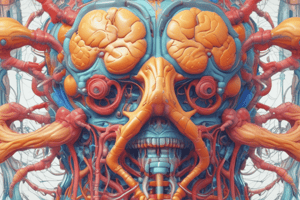Podcast
Questions and Answers
What is the main purpose of homeostasis?
What is the main purpose of homeostasis?
- To prevent any internal changes
- To amplify internal changes
- To shut down internal processes
- To maintain stable internal conditions (correct)
Who introduced the concept of homeostasis?
Who introduced the concept of homeostasis?
- Louis Pasteur
- Marie Curie
- Claude Bernard (correct)
- Charles Darwin
Which systems often control the feedback loops involved in homeostasis?
Which systems often control the feedback loops involved in homeostasis?
- Muscular and Skeletal Systems
- Respiratory and Digestive Systems
- Endocrine and Nervous Systems (correct)
- Circulatory and Immune Systems
What type of loops work to counteract changes in the body's internal environment?
What type of loops work to counteract changes in the body's internal environment?
How does the body regulate its core temperature when cold?
How does the body regulate its core temperature when cold?
What organ releases the hormone glucagon to raise blood sugar levels when they are low?
What organ releases the hormone glucagon to raise blood sugar levels when they are low?
What is an example of a negative feedback mechanism for regulating blood pressure?
What is an example of a negative feedback mechanism for regulating blood pressure?
What aspect of homeostasis is crucial for maintaining the overall function of an organism?
What aspect of homeostasis is crucial for maintaining the overall function of an organism?
How does homeostasis contribute to evolution from a developmental physiology perspective?
How does homeostasis contribute to evolution from a developmental physiology perspective?
Flashcards are hidden until you start studying
Study Notes
Homeostasis
Introduction
Homeostasis is the process by which living organisms maintain relatively constant internal conditions. This concept is central to physiology as it is the self-regulating mechanism that allows organisms to adapt and survive in changing external environments. The term homeostasis originated from the work of Claude Bernard, a French physiologist who introduced the notion of an internal environment, or "milieu interne," that must be maintained stable to ensure proper biological function.
Definition
Homeostasis is a dynamic process that involves negative feedback loops, which work to counteract changes in the body's internal environment and maintain stability. These feedback loops are often controlled by the endocrine and nervous systems, which send commands to other organs to carry out specific functions.
Key Points
- Homeostasis: The tendency to maintain a stable, relatively constant internal environment.
- Negative Feedback Loops: Act to oppose stimuli that trigger them, working to maintain stability.
- Positive Feedback Loops: Amplify their initiating stimuli, moving the system away from its starting state.
- Maintaining Homeostasis: Biological systems constantly work to detect and oppose changes in their internal environment, often through negative feedback loops.
Examples of Homeostasis
- Temperature Regulation: The body maintains its core temperature within a narrow range through feedback mechanisms, such as shivering to produce heat when cold or sweating to release heat when hot.
- pH Regulation: Organisms use buffers and other mechanisms to maintain control over the pH within their cells, ensuring that enzymes and other biochemical reactions can take place effectively.
- Glucose Regulation: The pancreas releases the hormone glucagon to raise blood sugar levels when they are low, maintaining homeostasis.
- Blood Pressure Regulation: The body maintains a relatively constant blood pressure through negative feedback mechanisms, such as the release of hormones that dilate or constrict blood vessels.
Homeostasis in Evolution
Homeostasis can also be seen as the mechanism of evolution. From the perspective of developmental physiology, homeostasis is a robust, dynamic, intergenerational, and diachronic (across-time) mechanism for the maintenance, perpetuation, and modification of physiologic structure and function.
Conclusion
Homeostasis is a fundamental concept in physiology, allowing organisms to maintain relatively constant internal conditions that enable them to adapt and survive in their environment. This process involves negative feedback loops controlled by the endocrine and nervous systems and is crucial for maintaining the overall function of the organism. Understanding homeostasis is essential for comprehending the function of the body in health and disease, as disruptions in homeostatic mechanisms can lead to disease.
Studying That Suits You
Use AI to generate personalized quizzes and flashcards to suit your learning preferences.




